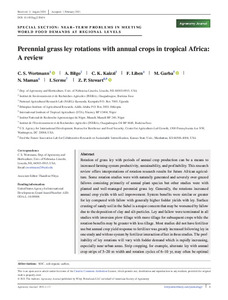| dc.contributor.author | Wortmann, C.S. |
| dc.contributor.author | Bilgo, A. |
| dc.contributor.author | Kaizzi, C.K. |
| dc.contributor.author | Liben, F. |
| dc.contributor.author | Garba, M. |
| dc.contributor.author | Maman, N. |
| dc.contributor.author | Serme, I. |
| dc.contributor.author | Stewart, Z.P. |
| dc.date.accessioned | 2022-09-20T12:21:12Z |
| dc.date.available | 2022-09-20T12:21:12Z |
| dc.date.issued | 2021 |
| dc.identifier.citation | Wortmann, C.S., Bilgo, A., Kaizzi, C.K., Liben, F., Garba, M., Maman, N., ... & Stewart, Z.P. (2021). Perennial grass ley rotations with annual crops in tropical africa: a review. Agronomy Journal, 1-7. |
| dc.identifier.issn | 0002-1962 |
| dc.identifier.uri | https://hdl.handle.net/20.500.12478/7777 |
| dc.description.abstract | Rotation of grass ley with periods of annual crop production can be a means to increased farming system productivity, sustainability, and profitability. This research review offers interpretations of rotation research results for future African agriculture. Some rotation studies were with naturally generated and severely over-grazed fallows consisting primarily of annual plant species but other studies were with planted and well-managed perennial grass ley. Generally, the rotations increased annual crop yields with soil improvement. System benefits were similar or greater for ley compared with fallow with generally higher fodder yields with ley. Surface crusting of sandy soil in the Sahel is a major concern that may be worsened by fallow due to the deposition of clay and silt particles. Ley and fallow were terminated in all studies with inversion plow tillage with more tillage for subsequent crops while the rotation benefits may be greater with less tillage. Most studies did not have fertilizer use but annual crop yield response to fertilizer was greatly increased following ley in one study and with no system by fertilizer interaction effect in three studies. The profitability of ley rotations will vary with fodder demand which is rapidly increasing, especially near urban areas. Strip cropping, for example, alternate ley with annual crop strips of 5–20 m width and rotation cycles of 6–10 yr, may often be optimal for erosion control and sediment trapping, protection from uncontrolled grazing, and nearby supply of vegetative planting material for ley re-establishment. Rotation management can be improved through experiential learning and experimentation. |
| dc.description.sponsorship | United States Agency for International Development |
| dc.format.extent | 1-7 |
| dc.language.iso | en |
| dc.subject | Grasses |
| dc.subject | Perennials |
| dc.subject | Crops |
| dc.subject | Tropical Africa |
| dc.subject | Farming Systems |
| dc.title | Perennial grass ley rotations with annual crops in tropical Africa: a review |
| dc.type | Journal Article |
| cg.contributor.affiliation | University of Nebraska-Lincoln |
| cg.contributor.affiliation | Institut de Environnement et de Recherches Agricoles, Burkina Faso |
| cg.contributor.affiliation | National Agricultural Research Laboratories, Uganda |
| cg.contributor.affiliation | Ethiopian Institute of Agricultural Research |
| cg.contributor.affiliation | International Institute of Tropical Agriculture |
| cg.contributor.affiliation | Institut National de Recherche Agronomique du Niger |
| cg.contributor.affiliation | United States Agency for International Development |
| cg.contributor.affiliation | Kansas State University |
| cg.coverage.region | Africa |
| cg.coverage.region | East Africa |
| cg.coverage.country | Uganda |
| cg.coverage.hub | Headquarters and Western Africa Hub |
| cg.identifier.bibtexciteid | WORTMANN:2021 |
| cg.isijournal | ISI Journal |
| cg.authorship.types | CGIAR and developing country institute |
| cg.iitasubject | Agronomy |
| cg.iitasubject | Crop Systems |
| cg.iitasubject | Food Systems |
| cg.iitasubject | Plant Breeding |
| cg.iitasubject | Plant Production |
| cg.journal | Agronomy Journal |
| cg.notes | Published online: 18 Feb 2021 |
| cg.accessibilitystatus | Open Access |
| cg.reviewstatus | Peer Review |
| cg.usagerightslicense | Creative Commons Attribution 4.0 (CC BY 0.0) |
| cg.targetaudience | Scientists |
| cg.identifier.doi | https://dx.doi.org/10.1002/agj2.20634 |
| cg.iitaauthor.identifier | Garba Maman: 0000-0002-3377-3064 |
| cg.futureupdate.required | No |
| cg.contributor.acknowledgements | Manuscript preparation was made possible with the support of the American People provided to the Feed the Future Innovation Lab for Sustainable Intensification through the U.S. Agency for International Development (USAID). The contents are the sole responsibility of the authors and do not necessarily reflect the views of USAID or the U.S. Government. Program activities are funded by the U.S. Agency for International Development (USAID) under Cooperative Agreement no. AID-OAA-L-14-00006. |

